If you work in a job that utilizes a crane, hoist, derrick, or cableway to lift and move material, you’re operating under rules and regulation that likely originated from the ASME B30 Safety Standard.
The American Society of Mechanical Engineers (ASME) is a professional association and leading international developer of codes and standards associated with the art, science, and practice of mechanical engineering. ASME membership is comprised of engineers, scientists, government officials, and others who voluntarily contribute their technical expertise.
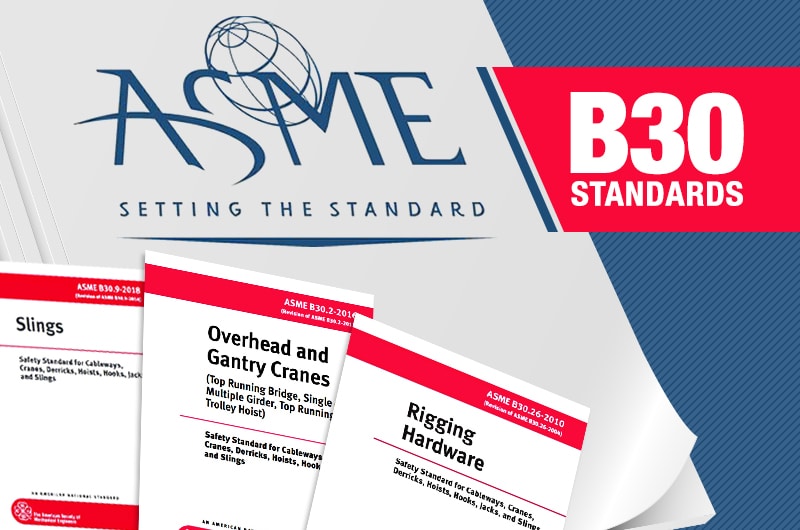
ASME standards and safety codes are intended to enhance public safety and offer best practices and applicable regulations within specific industries and jurisdictions. ASME standards are accredited as meeting the criteria of the American National Standards Institute (ANSI). ASME B30 is identified as the “Safety Standard for Cableways, Cranes, Derricks, Hoists, Hooks, Jacks, and Slings.” Every couple of years, the B30 Committee reviews, revises, and amends their existing standards and releases a new edition. The Committee revises the standards based on numerous considerations, including:
- Technological advances
- New data
- Changing environmental and industry needs
Today, ASME B30 exists as a suite of American National Standards with 30 unique volumes related to the design, installation, operation, inspection, and maintenance of different types of equipment utilized in construction processes.
The guidelines set forth by the experts on the B30 committee and sub-committees can help employers, manufacturers, end-users, and contractors keep themselves out of harm’s way and improve the safety performance and compliance of lifting and rigging equipment.
In this article, we’ll take a look at each volume of the ASME B30 Safety Standards as they apply to material handling equipment, cranes, hoists, rigging equipment, and below-the-hook lifting devices.
ASME B30 – Safety Standards for Cableways, Cranes, Derricks, Hoists, Hooks, Jacks, and Slings
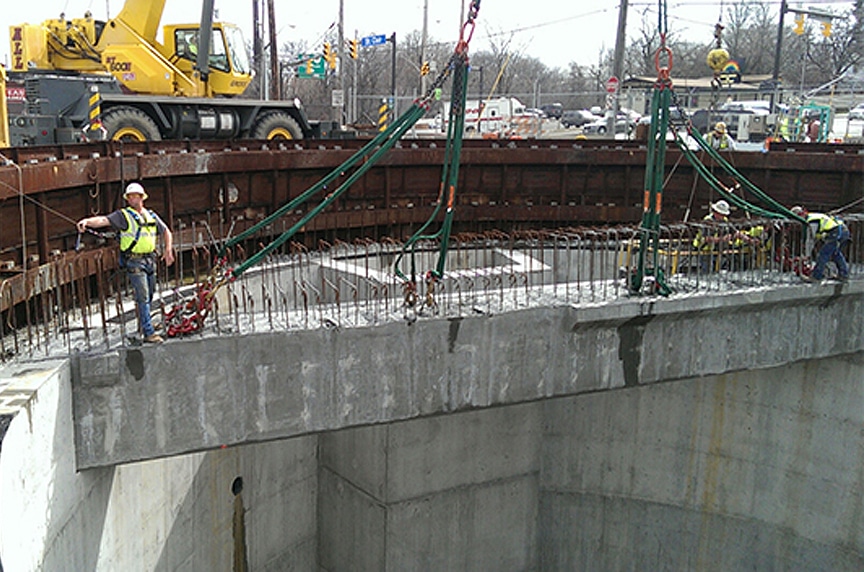
ASME B30.1 – Jacks, Industrial Rollers, Air Casters, and Hydraulic Gantries
ASME B30.1 includes provisions that apply to the construction, operation, inspection, testing, and maintenance of mechanical ratchet jacks, hand or power-operated mechanical screw jacks, hand or power-operated hydraulic jacks, air lifting bags, industrial rollers, air casters, telescopic hydraulic gantry systems, and strand jacks.
Not included in this Volume are jacks designed for automotive service, trip-lowered jacks, jacks designed for static support rather than load handling, and jacks, industrial rollers, air lifting bags or air casters that are an integral part of other equipment.
Topics Covered:
- Scope, Translations, Definitions, Personnel Competence, Responsibilities, and References
- Mechanical Jacks
- Hydraulic Jacks
- Air-Lifting Bags
- Industrial Rollers
- Air Casters
- Telescopic Hydraulic Gantry Systems
- Strand Jack Systems
ASME B30.2 – Overhead and Gantry Cranes (Top Running Bridge, Single or Multiple Girder, Top Running Trolley Hoist)
ASME B30.2 applies to the construction, installation, operation, inspection, and maintenance of hand-operated and power-driven overhead and gantry cranes that have a top-running single-girder or multiple-girder bridge, with one or more top-running trolley hoists used for vertical lifting and lowering of freely suspended, unguided loads consisting of equipment and materials.
The requirements included in this Volume also apply to cranes having the same fundamental characteristics such as cantilever gantry cranes, semi-gantry cranes, and wall cranes.
Requirements for a crane used for a special purpose such as, but not limited to, non-vertical lifting service, lifting a guided load, or lifting personnel are not included in this Volume.
Topics Covered:
- Scope, Definitions, References, and Personnel Competence
- General Construction and Installation
- Inspection and Testing
- Operator Training and Operation
- Maintenance Training and Maintenance
ASME B30.3 – Tower Cranes
ASME B30.3 applies to “construction tower cranes” and “permanently mounted tower cranes” that are powered by electric motors or internal combustion engines and that adjust their operating radius by means of a luffing boom mechanism, a trolley traversing a horizontal jib, or a combination of the two. The cranes may be mounted on “fixed bases” or “traveling bases” and may have tower and supporting structure arrangements that permit the crane to climb in a structure being built or that permits’ increasing the crane’s tower height as the structure rises.
Variations of the above physical characteristics that provide the same fundamental operating characteristics are included in the scope of this Volume however, the requirements of this Volume are only applicable to the cranes within this scope when they are used in lifting operations.
Mobile cranes configured with tower attachments (refer to ASME B30.5) and self-erecting tower cranes (refer to ASME B30.29) are not within the scope of this Volume.
Topics Covered:
- Scope, Definitions, References, and Personnel Competence
- Erection, Climbing and Dismantling, Characteristics, and Construction
- Inspection, Testing, and Maintenance
- Operation
ASME B30.4 – Portal and Pedestal Cranes
ASME B30.4 applies to the construction, installation, operation, inspection, testing and maintenance of electric motor or internal-combustion engine powered portal and pedestal cranes, that adjust operating radius by means of a boom luffing mechanism or by means of a trolley traversing a horizontal boom, that may be mounted on a fixed or traveling base, and to any variation thereof that retain the same fundamental characteristics.
This standard applies only to portal and pedestal cranes utilizing a drum and wire rope for hoisting and which are used for hoisting work. The requirements for tower cranes (refer to ASME B30.3), telescopic boom cranes (refer to ASME B30.5), and knuckleboom cranes (refer to ASME B30.22) are not included in this standard.
Topics Covered:
- Scope, Definitions, Personnel Competence, and References
- Erection, Characteristics, and Construction
- Inspection, Testing, and Maintenance
- Operation
ASME B30.5 – Mobile and Locomotive Cranes
ASME B30.5 addresses crawler cranes, locomotive cranes, wheel-mounted cranes, and any variations thereof that retain the same fundamental characteristics and are powered by internal combustion engines or electric motors. The scope of this Safety Standard includes only cranes of the above types that are powered by internal combustion engines or electric motors. Side boom tractors and cranes designed for railway and automobile wreck clearance, digger derricks, cranes manufactured specifically for, or when used for, energized electrical line service, knuckle boom, trolley boom cranes, and cranes having a maximum rated capacity of one ton or less are excluded. This 2018 edition revises the Crane Operation in the Vicinity of Electric Power Lines section entirely, adds a new section on Rigger Responsibilities, and incorporates other miscellaneous revisions.
ASME B30.5 offers comprehensive solutions applying to the construction, inspection, testing, maintenance and operation of mobile and locomotive cranes. It is to be used in conjunction with equipment described in other volumes of the ASME B30 series of safety standards. Careful application of these B30 Safety Standards will help users to comply with applicable regulations within their jurisdictions, while achieving the operational and safety benefits to be gained from the many industry best-practices detailed in these volumes.
Intended for manufacturers, owners, employers, users and others concerned with the specification, buying, maintenance, training and safe use of mobile and locomotive cranes with B30 equipment, plus all potential governing entities.
Topics Covered:
- Scope, Definitions, Personnel Competence, and References
- Construction and Characteristics
- Inspection, Testing, and Maintenance
- Operation
ASME B30.6 – Derricks
ASME B30.6 applies to the construction, installation, operation, inspection, testing, and maintenance of guy, stiffleg, basket, breast, gin pole, Chicago boom, shearleg, and A-frame derricks. These derricks, powered by winches through systems of wire rope reeving, are used for lifting, lowering, and horizontal movement of freely suspended unguided loads. Derricks are usually stationary mounted and may be temporarily or permanently installed.
The provisions included in this volume also apply to any variations of these types of derricks with the same fundamental characteristics, except those specified for floating derricks in ASME B30.8, Floating Cranes and Floating Derricks.
Topics Covered:
- Scope, Definitions, Translations, Personnel Competence, and References
- Construction and Installation
- Inspection, Testing, and Maintenance
- Operation
ASME B30.7 – Winches
ASME B30.7 includes provisions that apply to the construction, installation, operation, inspection, testing and maintenance of winches arranged for mounting on a foundation or other supporting structure for moving loads. Winches addressed in this volume are those typically used in industrial, construction and maritime applications.
The requirements included in this volume apply to winches that are powered by internal combustion engines, electric motors, compressed air or hydraulics and that utilize drums and rope.
This volume does not apply to overhead hoists, mine hoists, capstans or winches installed as an integral part of the lifting system of other B30 equipment.
Topics Covered:
- Scope, Definitions, Personnel Competence, and References
- Construction and Installation
- Inspection, Testing, and Maintenance
- Operations
ASME B30.8 – Floating Cranes and Floating Derricks
ASME B30.8 applies to cranes and derricks mounted on barges or pontoons. Floating cranes are convertible for excavation service and other uses that are categorically not considered to be lifting service.
The requirements of this volume are applicable only to floating cranes and floating derricks used for vertical lifting and lowering of freely suspended unguided loads.
Topics Covered:
- Scope, Definitions, Personnel Competence, Translations, and References
- Construction and Installation
- Inspection, Testing, and Maintenance
- Operation
ASME B30.9 – Slings
ASME B30.9 includes provisions that apply to the fabrication, attachment, use, inspection, testing, and maintenance of slings used for load handling purposes, used in conjunction with equipment described in other volumes of the B30 Standard, except as restricted in ASME B30.12 and ASME B30.23.
Slings fabricated from alloy steel chain, wire rope, metal mesh, synthetic fiber rope, synthetic webbing, and polyester fiber yarns in a protective cover(s) are addressed.
Careful application of B30 safety standards will help users to comply with applicable regulations within their jurisdictions, while achieving the operational and safety benefits to be gained from the many industry best-practices detailed in these volumes.
Intended for manufacturers, owners, employers, users and others concerned with the specification, buying, maintenance, training and safe use of slings and hooks with B30 equipment, plus all potential governing entities.
Topics Covered:
- Scope, Definitions, Personnel Competence, Rigger Responsibilities, Translations, and References
- Alloy Steel Chain Slings: Selection, Use, and Maintenance
- Wire Rope Slings: Selection, Use, and Maintenance
- Metal Mesh Slings: Selection, Use, and Maintenance
- Synthetic Rope Slings: Selection, Use, and Maintenance
- Synthetic Webbing Slings: Selection, Use, and Maintenance
- Polyester Roundslings: Selections, Use, and Maintenance
- High-Performance Roundslings: Selection, Use, and Maintenance
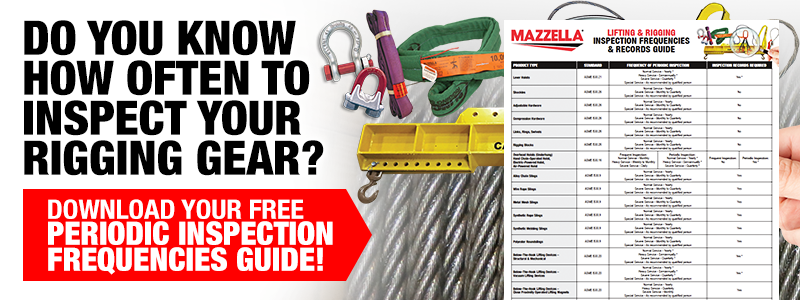
ASME B30.10 – Hooks
ASME B30.10 includes provisions that apply to the fabrication, attachment, use, inspection, and maintenance of hooks used for load handling purposes, in conjunction with equipment described in other volumes of the B30 Standard.
Hooks supporting a load in the base (bowl/saddle or pinhole) of the hook are covered, as well as hooks that may be loaded in other than the base (bowl/saddle or pinhole).
Topics Covered:
- Scope, Definitions, References, Personnel Competence, and Translations
- Hooks: Selection, Use, and Maintenance
- Hooks – Miscellaneous: Selection, Use, and Maintenance
ASME B30.11 – Monorails and Underhung Cranes
ASME B30.11 includes provisions that apply to the construction, installation, operation, inspection, testing, and maintenance of underhung crane and monorail systems, track sections, and load-carrying members, such as end trucks or carriers (commonly called trolleys) that travel either on the external or internal lower flange of a track section. The track sections include single monorail track, crane bridge girders and jib booms, all curves, switches, transfer devices, and lift and drop sections.
Provisions apply to both power-driven and hand-operated equipment in which the carriers are independently controlled. Items within this scope may be referred to as “equipment.”
Provisions for similar equipment used for a special purpose, such as, but not limited to, nonvertical lifting service, lifting a guided load, conveyor systems, including power and free conveyors, and lifting or transporting personnel are not included in this Volume.
Topics Covered:
- Scope, Definitions, and References
- Construction and Installation
- Inspection and Testing
- Operator Training and Operation
- Maintenance Training and Maintenance
ASME B30.12 – Handling Loads Suspended from Rotorcraft
ASME B30.12 addresses the handling of loads suspended from rotorcraft using cargo sling or powered hoist, or other attaching means to lift, carry, pull, or tow a jettisonable load outside of the rotorcraft airframe.
Topics Covered:
- Scope, Definitions, and References
- External Load Ratings and Characteristics
- Lifting Components
- Inspection and Maintenance
- Operations
- Handling the Load
- Signals and Communication
- Fueling and Ground-Based Facilities at the Work Area
ASME B30.13 – Storage/Retrieval (S/R) Machines and Associated Equipment
ASME B30.13 applies to storage/retrieval (S/R) machines and associated equipment, such as aisle transfer cars and aisle equipment, and interfaces with other material handling equipment covered under other standards.
The provisions of this Standard applying to S/R machines shall apply equally to the construction, installation, inspection, testing, maintenance, and operation of aisle transfer cars and any load handling equipment which is part of or attached to S/R machines or aisle transfer cars.
Topics Covered:
- Scope, Definitions, References, and Personnel Competence
- Construction and Installation
- Inspection, Testing, and Maintenance
- Operation
ASME B30.14 – Side Boom Tractors
ASME B30.14 applies to the construction, installation, operation, inspection, testing, and maintenance of side boom tractors powered by an internal combustion engine used for pipe laying or lifting operations, utilizing a lifting boom, drum, wire rope, and/or hydraulic cylinders.
The requirements for a side boom tractor that is used for other than lifting operations such as when converted for excavating work, and a side boom tractor with a rated load of one ton or less, are not included in this Volume.
Topics Covered:
- Scope, Definitions, Translation, Personnel Competence, and References
- Construction and Characteristics
- Inspection, Testing, and Maintenance
- Operation
ASME B30.16 – Overhead Underhung and Stationary Hoists
ASME B30.16 includes provisions that apply to the construction, installation, operation, inspection, testing, and maintenance of overhead underhung and stationary hoists including hand chain-operated, electric-powered and air-powered chain and wire rope hoists used for, but not limited to, vertical lifting and lowering of freely suspended, unguided loads that consist of equipment and materials.
Requirements for a hoist that is used for a special purpose, such as, but not limited to, tensioning a load, non-vertical lifting service, lifting a guided load, lifting personnel, or drawing both the load and the hoist up or down the load chain or rope when the hoist is attached to the load, are not included in this Volume.
Topics Covered:
- Scope, Definitions, Personnel Competence, and References
- Marking, Construction, and Installation
- Inspection and Testing
- Operator Training and Operation
- Maintenance Training and Maintenance
ASME B30.17 – Cranes and Monorails (With Underhung Trolley or Bridge)
ASME B30.17 includes provisions that apply to the construction, installation, operation, inspection, testing and maintenance of hand-operated and power-operated overhead cranes and monorail systems with either an underhung trolley or bridge, or both. These cranes and monorail systems shall support one or more hoists used for vertical lifting and lowering of freely suspended, unguided loads, and include top running and underhung bridge cranes, gantry cranes, traveling wall cranes, jib cranes, polar gantry cranes, portable gantries, other cranes having the same fundamental characteristics, and monorail systems including trolleys (carriers) and end trucks.
Track sections and their support systems for monorail systems, runways and their support systems for underhung cranes, and runway rails for top-running cranes, are also within the scope of this Volume.
Topics Covered:
- Scope, Definitions, References, and Personnel Competence
- General Construction and Installation
- Inspection, Testing, and Maintenance
- Operator Training and Operation
- Maintenance Training and Maintenance
ASME B30.18 – Stacker Cranes (Top or Under Running Bridge, Multiple Girder with Top or Under Running Trolley Hoist)
ASME B30.18 applies to the construction, installation, operation, inspection, and maintenance of hand-powered and power-driven overhead and gantry cranes that have a top or under running multiple girder bridge with a vertically guided carriage, with or without a top or under running trolley.
The requirements included in this volume also apply to stacker cranes having the same fundamental characteristics, such as cantilever gantry and semi-gantry stacker cranes.
Topics Covered:
- Scope, Definitions, Personnel Competence, and References
- General Construction and Installation
- Inspection, Testing, and Maintenance
- Operation
ASME B30.19 – Cableways
ASME B30.19 applies to the construction, installation, operation inspection, and maintenance of all load transporting hoisting and lowering cable supported systems operating on and supported from track cable(s).
This volume does not apply to skyline systems as used in the logging industry or slackline systems used for excavating.
Topics Covered:
- Scope, Definitions, Personnel Competence, and References
- Construction and Characteristics
- Inspection, Testing, and Maintenance
- Operation
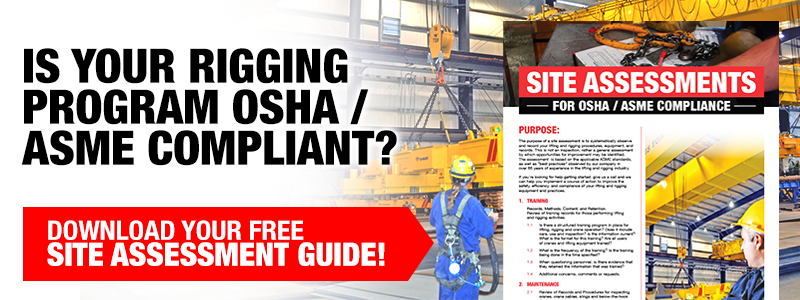
ASME B30.20– Below-the-Hook Lifting Devices
ASME B30.20 includes provisions that apply to the marking, construction, installation, inspection, testing, maintenance, and operation of below-the-hook lifting devices, other than components addressed by other ASME B30 volumes or other standards, used for attaching loads to a hoist.
The requirements in this Volume also apply to clamps used for positioning and anchoring.
Topics Covered:
- Scope, Definitions, Personnel Competence, Translations, and References
- Structural and Mechanical Lifting Devices
- Vacuum Lifting Devices
- Close Proximity Operated Lifting Magnets
- Remotely Operated Lifting Magnets
- Scrap and Material-Handling Grapples
- Clamps
ASME B30.21 – Lever Hoists
ASME B30.21 applies to the construction, installation, operation, inspection, and maintenance of ratchet and pawl and friction brake type lever chain, rope and web strap hoists used for lifting, pulling, and tensioning applications.
The requirements for a lever hoist that is used for a special purpose, such as lifting personnel, or drawing both the load and the hoist up or down the load chain, rope or web strap when the lever hoist is attached to the load, and a specially insulated hoist used for handling energized electrical power lines are not included in this volume.
Topics Covered:
- Scope, Definitions, Personnel Competence, and References
- Construction and Installation
- Inspection and Testing
- Operation and Operator Training
- Maintenance and Maintenance Training
ASME B30.22 – Articulating Boom Cranes
ASME B30.22 applies to the construction, installation, operation, inspection, and maintenance of cranes with knuckle booms articulated by hydraulic cylinders, which are powered by internal combustion engines or electric motors and are mounted on a mobile chassis or stationary installation.
Articulating cranes with load hoist mechanisms are covered by this volume. Some basic machine types within this scope are convertible for excavating work and other uses not considered to be lifting service. Requirements of this volume are applicable only to such machines when used as lifting cranes.
The following units are exempt from this volume:
- Maximum related capacity of 2,000 lbs. or less;
- Booms constructed of nonconductive type materials;
- Equipped with or designed primarily for personnel baskets, platforms, ladders, etc.;
- When equipped with non-lifting attachments;
- Forestry and logging applications;
- Telescoping boom cranes that do not articulate (covered under B30.5) and scrap and material handlers as defined in ASME B30.25.
Topics Covered:
- Scope, Definitions, Personnel Competence, Translations, and References
- Construction and Characteristics
- Inspection, Testing, and Maintenance
- Operation
ASME B30.23 – Personnel Lifting Systems
ASME B30.23 applies to hoisting equipment and accessory equipment covered within certain volumes of the ASME B30 Standard, that is used to lift, lower, or transport personnel in a platform, by wire rope or chain, from hoist equipment, or by a platform that is mounted on a boom of the hoist equipment. The lifting of personnel is not allowed using some ASME 30 Standard equipment.
The ASME B30 volume addressing the hoisting equipment to be used shall be consulted for the applicability of the ASME B30.23 volume.
Topics Covered:
- Scope, Definitions, Personnel Competence, Translations, and References
- Construction and Characteristics
- Inspections, Testing, and Maintenance
- Operation
ASME B30.24 – Container Cranes
ASME B30.24 includes provisions that apply to the construction, installation, operation, inspection, testing, and maintenance of container cranes used for lifting purposes, in conjunction with equipment described in other volumes of the B30 Standard.
This Volume includes power-operated cranes of the above type whose power source is either self-contained or provided externally; single, double, or box girder construction, utilizing a trolley and a container-handling spreader or other applicable lifting apparatus (cargo hook, cargo beam, magnet, etc.); and rail- or rubber tire-mounted with through-the-legs or between-the-legs operation. Use of the same hardware for purposes other than lifting is excluded from the provisions of this Volume.
This Volume does not apply to small industrial truck-type cranes, container-handling toploaders and sideloaders, or mobile straddle-type industrial lifts.
Topics Covered:
- Scope, Definitions, References, and Personnel Competence
- Construction and Installation
- Inspection, Testing, and Maintenance
- Operation
ASME B30.25 – Scrap and Material Handlers
ASME B30.25 includes provisions that apply to the construction, installation, operation, inspection, and maintenance of scrap and material handlers consisting of a base, a revolving upper structure with operator’s station(s), and a front for lifting scrap or materials using attachments such as magnets and grapples, and any variations thereof in which the equipment retains the same fundamental characteristics.
The provisions included in this Volume apply to scrap and material handlers that are crawler mounted, rail mounted, wheel mounted, or on pedestal bases. The scope includes hydraulically operated scrap and material handlers powered by internal combustion engines or electric motors to lift, lower, and swing scrap and material at various radii.
Hydraulic excavators designed for digging and trenching, forestry machines, machines designed for demolition, lattice and telescopic boom cranes, rail-mounted cranes for railway and automobile wreck clearance, and equipment covered by other volumes of this Standard are excluded.
Topics Covered:
- Scope, Definitions, Personnel Competence, and References
- Construction and Characteristics
- Inspection, Testing, and Maintenance
- Operation
ASME B30.26 – Rigging Hardware
ASME B30.26 applies to the construction, installation, operation, inspection, and maintenance of detachable rigging hardware used for load handling activities in conjunction with equipment described in other volumes of the B30 Standard.
This hardware includes shackles, links, rings, swivels, turnbuckles, eyebolts, hoist rings, wire rope clips, wedge sockets, rigging blocks and load indication devices.
Topics Covered:
- Scope, Definitions, Personnel Competence, Translations, and References
- Shackles – Selection, Use, and Maintenance
- Adjustable Hardware – Selection, Use, and Maintenance
- Compression Hardware – Selection, Use, and Maintenance
- Links, Master Link Subassemblies, Rings, and Swivels
- Rigging Blocks – Selection, Use, and Maintenance
- Detachable Load-Indicating Devices – Selection, Use, and Maintenance
ASME B30.27 – Material Placement Systems
ASME B30.27 applies to the construction, installation, operation, inspection, testing, and maintenance of trailer and truck-mounted material placement systems. Included in this are mechanical and hydraulic pea gravel systems, mobile telescoping boom conveyors, separate placing booms, and material placement accessories. Truck-mounted material placement systems can be either with or without an integral placing boom.
This Volume does not apply to conveyor parts of mobile telescoping boom conveyors, mortar conveying or spraying machines, or dry mix shotcreting machines. The conveyor section of these machines is covered by ASME B20.1.
Topics Covered:
- Scope, Definitions, References, and Personnel Competence
- Construction and Installation
- Inspection, Testing, and Maintenance
- Operation
ASME B30.28 – Balance Lifting Units
ASME B30.28 includes provisions that apply to the marking, construction, installation, inspection, testing, maintenance and operation of Balance Lifting Units (Balancers). Balancers are distinguished by their ability to float the load. This volume applies to Balancers with fixed arm support and Balancers with overhead flexible lifting medium.
This standard does not apply to Balancers with autonomous operation or Balancers used for lifting personnel, as these units require additional considerations, provisions and features that are not included in this volume.
Topics Covered:
- Scope, Definitions, References, Translations, and Personnel Competence
- Marking, Construction, and Installation
- Inspection, Testing, and Maintenance
- Operation
ASME B30.30 – Ropes
ASME B30.30 includes provisions that apply to the construction, selection, installation, attachment, testing, inspection, maintenance, repair, use, and replacement of wire rope, hybrid rope, and synthetic fiber rope and rope-lifting components used in conjunction with equipment addressed in the ASME B30 Standard.
These provisions apply to a particular volume when B30.30 is referenced and as specified in that volume.
Topics Covered:
- Scope, Definitions, Personnel Competence, Translations, and References
- Steel Wire Rope
- Synthetic Rope
Wrapping it up
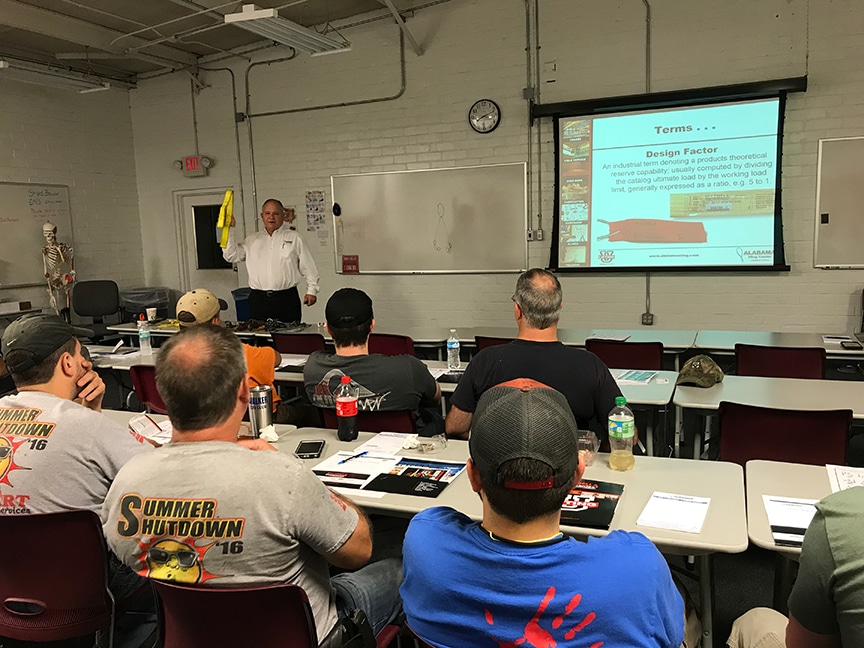
While all 30 volumes of the B30 Safety Standard may not apply to the equipment you use, or the job you perform, there’s a good chance that several standards will apply to the design, construction, use, inspection, and maintenance of equipment that you are using.
Fortunately, ASME/ANSI have created standards packages that bundle several ASME B30 standards together by topic. You can buy all 30 standards together as part of the ASME B30 Construction Package, buy individual standard volumes, or buy packages by topic including:
- ASME B30.5 / ASME B30.22 / ASME B30.26 – Cranes Package
- ASME B30.2 / ASME B30.11 / ANSI/ASME B30.17 – Cranes Package
- ASME B30.16 / ASME B30.11 / ANSI/ASME B30.17 – Hoists Package
- ASME B30.5 / ASME B30.20 / ASME B30.9 – Mobile and Locomotive Cranes Package
- ASME B30.20 / ASME B30.26 / ASME B30.10 – Below the Hook and Rigging Hardware Package
- ASME B30.9 / ASME B30.10 – Slings and Hooks Package
- ASME B30.20 / ASME BTH-1 – Below the Hook lifting Devices Package
- ASME B30.2 / ASME B30.16 – Overhead Hoists and Gantry Cranes Package
- ASME B30.2 / ASME B30.10 / ASME B30.11 / ASME B30. 16 – Hooks Hoist and Cranes Package
- ASME B30.2 / ASME B30.9 /ASME B30.10 / ASME B30.20 – Gantry Cranes and Slings Package
- ASME B30.9 / ASME B30.16 / ASME B30.20 / ASME B30.26 – Slings Hoists and Hooks Package
If you have questions about what standards apply to the work you perform or the equipment you’re using, we can help. We offer lifting and rigging training and we have certified inspectors that can perform OSHA/ASME compliant inspections of your overhead cranes, hoists, lifting slings, rigging hardware, and personal fall protection equipment.
If you’d like more information on how you can make your lifting and rigging program compliant, set up a consultation with a lifting specialist to schedule a Site Assessment today!

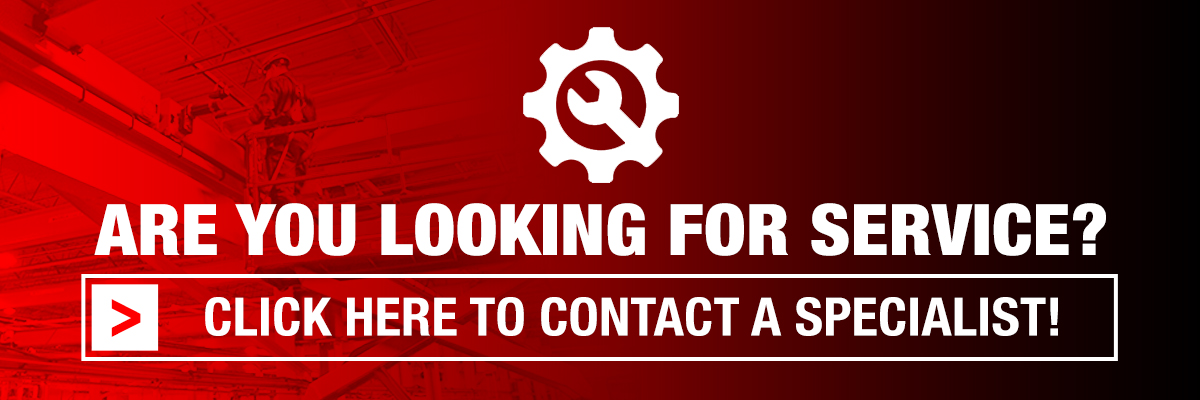
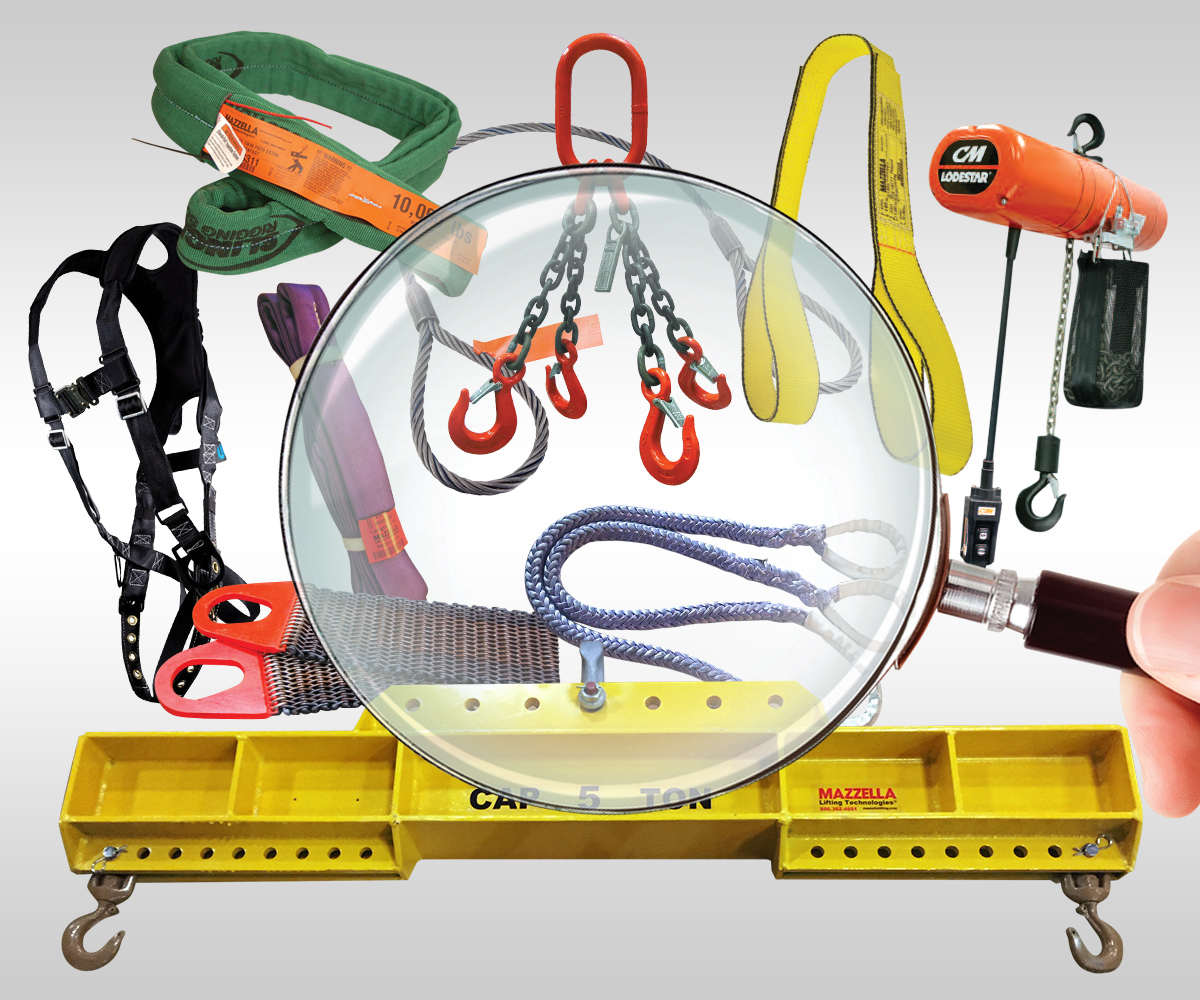
Rigging Inspection Services
OSHA 1910.184, ASME B30.9, B30.20, B30.26, & ANSI Z359 require periodic, documented inspections on slings, rigging hardware, lifting devices, and fall protection every 12 months, at minimum, and monthly to quarterly in more severe service conditions.
Call us at 800.362.4601 or click here if you need inspections for slings, rigging hardware, lifting devices, or fall protection!
Copyright 2019. Mazzella Companies.
